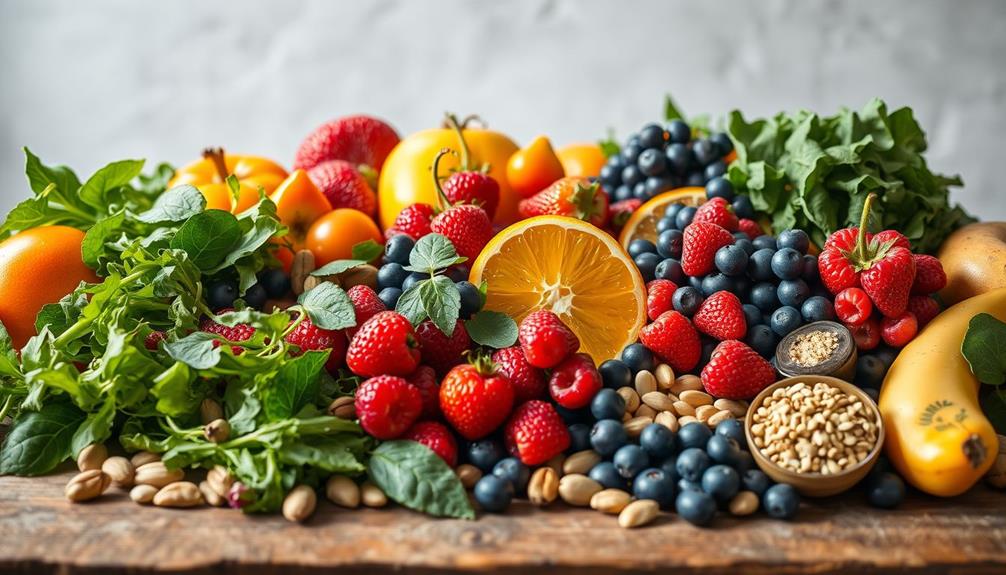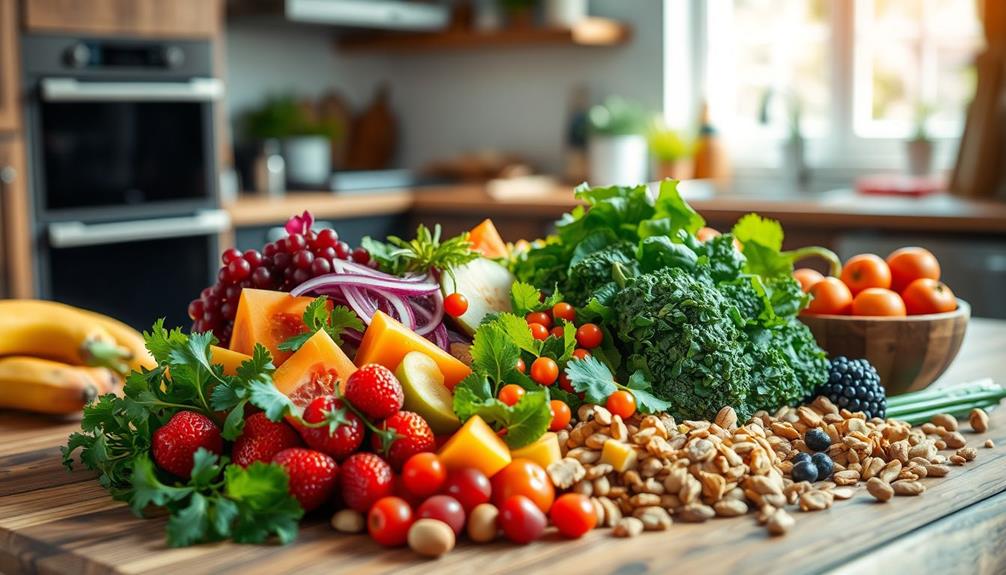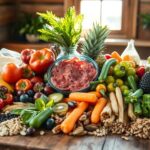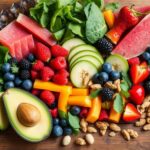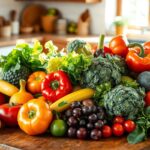A raw food diet focuses on uncooked and unprocessed foods, letting you enjoy a variety of fruits, vegetables, nuts, and seeds. You won't heat foods above 118°F, which helps retain nutrients and enzymes. There are different variations, like raw vegan or raw omnivorous diets. Many people experience increased energy, weight loss, and better overall health, although you need to plan carefully to avoid deficiencies, especially in vitamin B12 and iron. Engaging with communities and exploring recipes can enhance your journey. Stick around to uncover essential tips and insights for maintaining a balanced raw food lifestyle.
Key Takeaways
- A raw food diet consists primarily of uncooked and unprocessed foods, including fruits, vegetables, nuts, seeds, and sprouted grains.
- Cooking temperatures for raw food are kept below 118°F (48°C) to preserve nutrients and enzymes.
- Variations of the diet include raw vegan, raw vegetarian, and raw omnivorous, each with different allowances for animal products.
- Health benefits may include weight loss, increased energy, and lower chronic disease risk, but careful planning is needed to avoid nutrient deficiencies.
- Key preparation techniques involve soaking, sprouting, and dehydrating to enhance nutrient absorption and create raw snacks.
Understanding the Raw Food Diet
The raw food diet revolves around the idea of eating uncooked and unprocessed foods, primarily focusing on fruits, vegetables, nuts, seeds, and sprouted grains. You won't exceed cooking temperatures of 118°F (48°C) to preserve the nutrient content and enzymes believed to aid digestion.
This diet can vary; for instance, a raw vegan diet excludes all animal products, while a raw omnivorous approach might include raw meats and fish. Advocates of the raw food diet tout numerous health benefits, including enhanced nutrient absorption, increased energy, weight loss, and lower risks of chronic diseases.
However, it's important to recognize potential nutrient deficiencies, especially in vitamin B12 and iron, which can arise if you don't plan carefully.
Preparation methods for raw foods include juicing, blending, dehydrating, soaking, and sprouting. These techniques help you enjoy a variety of flavors and textures while keeping your meals nutritious.
Be cautious, though—consuming raw animal products can increase the risk of foodborne illnesses. Understanding the raw food diet's principles and potential challenges is significant for anyone looking to adopt this lifestyle.
Allowed Foods and Preparation
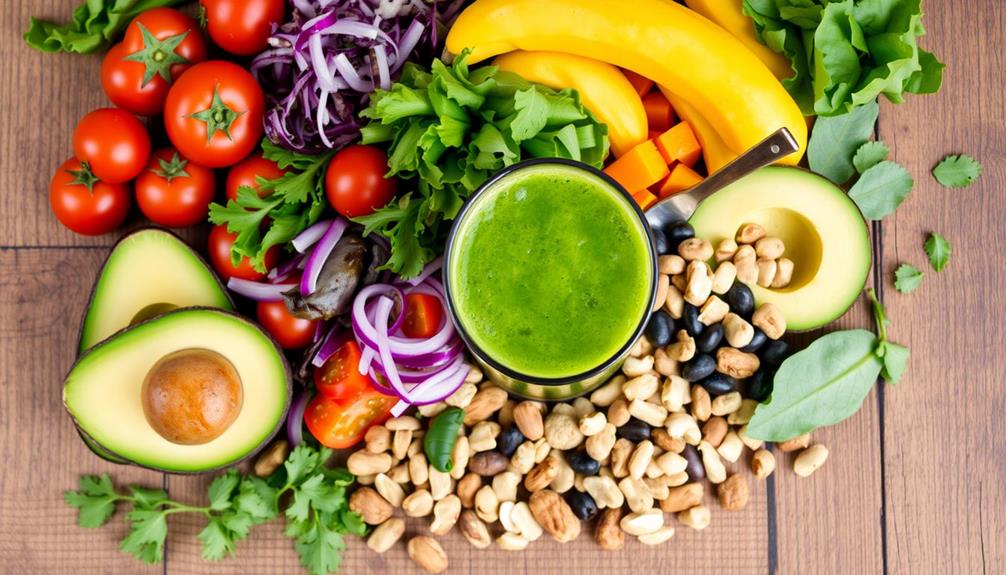
In a raw food diet, you'll focus on uncooked fruits, vegetables, nuts, and seeds, aiming for a high percentage of raw foods.
This diet is rich in antioxidants and vitamins, similar to the benefits found in celery juice overview, and emphasizes the consumption of natural, whole foods.
You'll also use specific preparation methods like juicing and dehydrating to keep nutrients intact and enhance flavors.
It's essential to steer clear of processed foods and choose organic options for the best health benefits.
Food Types Allowed
Embracing a raw food diet means enjoying a vibrant array of uncooked, unprocessed plant-based foods. You'll primarily focus on fresh fruits and vegetables, which are bursting with life and nutrients.
Additionally, exploring various brewing methods can enhance your enjoyment of beverages that complement your meals. Here are some delicious options you can include:
- Fruits: Think juicy berries, crisp apples, and ripe bananas that satisfy your sweet tooth naturally.
- Vegetables: Crunchy carrots, invigorating cucumbers, and leafy greens add color and vital vitamins to your meals.
- Nuts and Seeds: Almonds, walnuts, and chia seeds not only provide healthy fats but also keep you feeling full.
Additionally, you can enjoy raw honey for a touch of sweetness and sprouted grains that offer unique textures and nutrients.
It's crucial to remember that all foods should remain below 118°F (48°C) to maintain their raw status.
While the focus is on plant-based foods, some variations of the diet allow for unpasteurized dairy, raw eggs, and certain animal products, depending on your preferences.
Just steer clear of anything processed, refined, or tinned to truly embrace the raw lifestyle!
Preparation Techniques Explained
While exploring the raw food diet, you'll discover that preparation techniques play a vital role in maximizing the health benefits of your meals. Key methods include soaking, sprouting, and dehydrating, all designed to enhance nutrient availability and digestibility.
For instance, by employing techniques similar to those used in a gout nutrition guide, you can create dishes that are both nutritious and supportive of your overall health. Soaking beans and grains not only reduces anti-nutrients but also improves nutrient absorption, making these foods more beneficial for your body. On the other hand, sprouted grains are highly favored for their superior nutritional profile.
Dehydrating is another popular technique within the raw food diet. It allows you to create tasty snacks like raw crackers or fruit leathers while preserving the raw status of your ingredients.
However, food safety practices are fundamental in this diet. Always thoroughly wash your raw fruits and vegetables to prevent contamination and be cautious with high-risk foods, such as raw eggs and meats.
If you choose to include unprocessed dairy or raw eggs, verify they come from reliable sources to minimize health risks.
Health Benefits and Risks

Noticing the increasing popularity of the raw food diet, many people are drawn to its touted health benefits, including a higher intake of fruits and vegetables. By embracing this plant-based diet, you might enjoy several advantages:
- Lower risks of chronic diseases: The nutrient density and fiber content promote heart health and reduce the likelihood of diabetes. Additionally, incorporating important oils like eucalyptus oil may enhance overall wellness and respiratory function.
- Weight loss: Raw foods are often less processed and lower in calories, helping you feel full while consuming fewer calories.
- Increased energy: Many raw food enthusiasts report feeling more energized due to the abundance of vitamins and minerals.
However, it's important to be aware of the risks associated with the raw food diet. There's a heightened risk of foodborne illness, especially from consuming raw meats, eggs, and dairy.
Additionally, you could face nutritional challenges, such as vitamin deficiencies in B12, iron, calcium, and omega-3 fatty acids, which could lead to serious health issues.
To maintain a balanced diet, careful meal planning and food safety practices are significant. Balancing the benefits and risks will help you make informed decisions about adopting a raw food lifestyle.
Nutritional Insights and Challenges
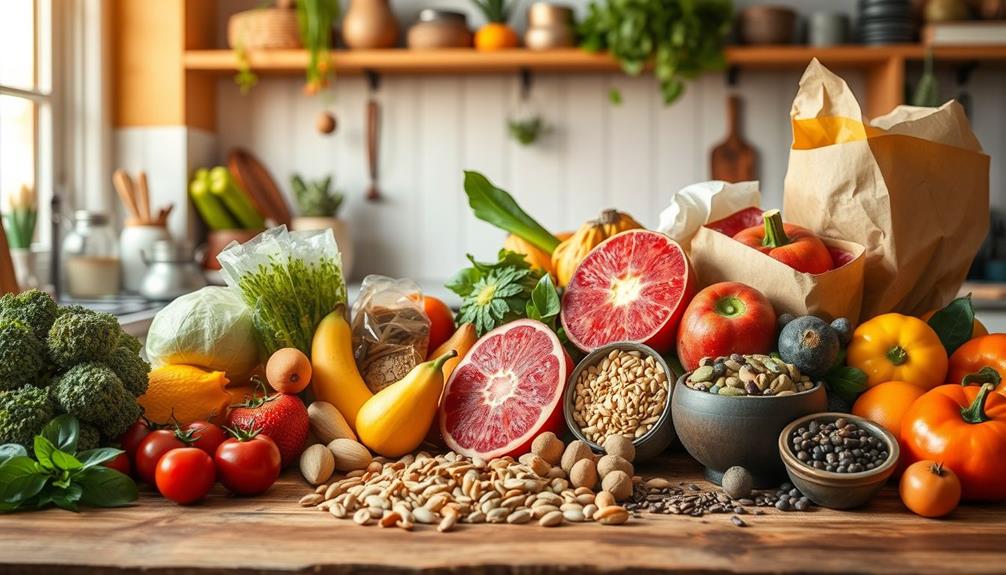
What nutritional insights should you consider when exploring the raw food diet? While this diet is packed with vitamins and minerals from fruits, vegetables, nuts, and legumes, it may fall short in essential nutrients like vitamin B12, iron, and omega-3 fatty acids. You might face challenges in achieving adequate protein intake, necessitating careful meal planning or supplementation.
Here's a quick overview of potential nutritional challenges:
| Nutrient | Potential Issues | Solutions |
|---|---|---|
| Vitamin B12 | Deficiency risk | Fortified foods/supplements |
| Protein | Inadequate intake | Combine plant proteins |
| Fiber | Digestive issues | Gradual increase |
| Bone Health | Lower bone mass | Include calcium-rich foods |
Moreover, the high fiber content can hinder nutrient absorption and lead to lower caloric intake. Long-term adherence may result in serious health risks, including irregular menstrual cycles in women. Finally, prioritize food safety, as consuming raw animal products and certain vegetables can increase the risk of foodborne illnesses, emphasizing the need for thorough washing and careful preparation.
Types of Raw Food Diets
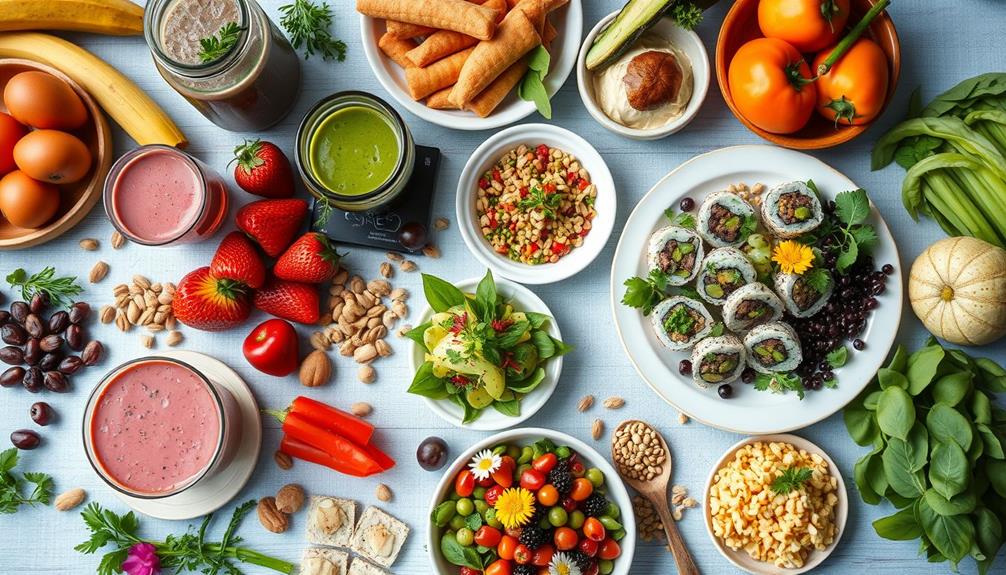
There are several types of raw food diets, each offering a unique approach to nutrition and food choices. Depending on your preferences, you might explore the following:
1. Raw Vegan Diet: This strictly excludes all animal products, focusing solely on plant-based foods like fruits, vegetables, nuts, and seeds. It emphasizes the health benefits of unprocessed plant nutrients.
A raw vegan diet can also lead to animal welfare considerations, as it promotes a lifestyle free from animal exploitation, similar to what's seen in hamster care and costs.
2. Raw Vegetarian Diet: This includes plant-based foods along with raw dairy products and eggs. This variation allows for a broader spectrum of nutrients while still adhering to raw principles.
3. Raw Omnivorous Diet: This diet combines plant-based foods with raw animal products, including meats and fish. Some followers believe that consuming these items provides additional nutrients that cooking destroys.
Each type stresses the importance of not heating food above 104–118°F (40–48°C) to preserve nutrients and enzymes believed to be beneficial for health.
You might find variability as some individuals include small amounts of cooked foods or tolerate specific processed items. Whichever path you choose, understanding these dietary variations can help you make informed decisions about your raw food journey.
Practical Tips for Beginners
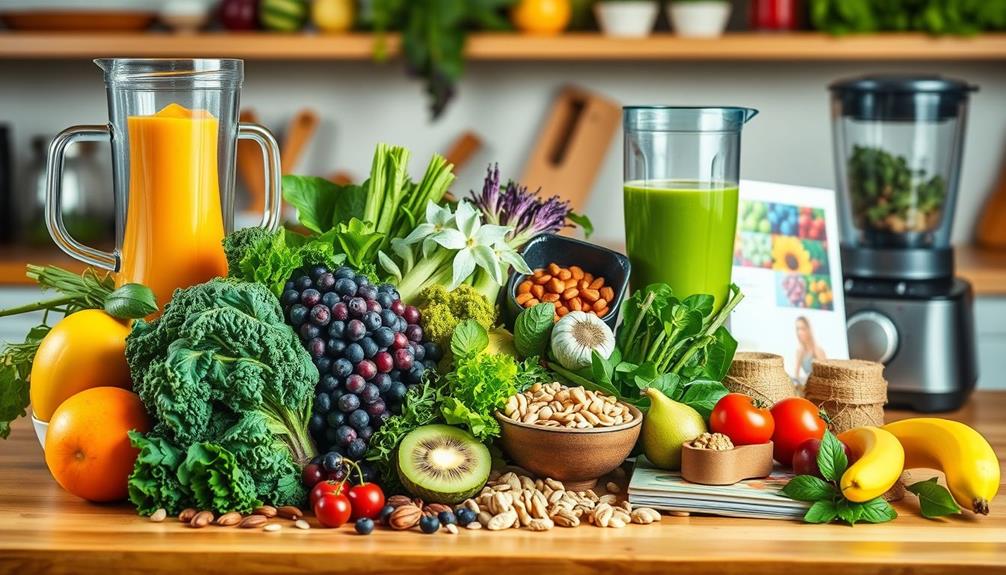
Starting a raw food diet can feel overwhelming, but taking it step by step makes the change smoother. Begin by gradually incorporating raw foods into your meals. Aim for a balanced mix of fruits and vegetables, nuts, and seeds to discover what you enjoy.
Investing in kitchen tools like a good blender and food processor can simplify meal preparation and enhance the variety of raw dishes you create. Additionally, understanding the importance of best soil for plants can help if you decide to grow your own herbs and vegetables to complement your raw meals.
Engage with online communities and local groups focused on raw food diets. These resources provide support, recipe ideas, and tips from experienced followers to keep you motivated. When choosing produce, prioritize seasonal and local options to maximize flavor and nutritional value.
Always be mindful of food safety by thoroughly washing raw fruits and vegetables. Planning your meals is essential to guarantee you meet your nutritional needs. The raw food diet can lead to deficiencies in key nutrients like vitamin B12, iron, and protein without proper planning.
Utilize these practical tips to navigate your new healthful diet confidently, and remember that the change is a journey—take your time to explore and enjoy raw foods!
Frequently Asked Questions
What Does a Raw Food Diet Consist Of?
A raw food diet consists of uncooked fruits, vegetables, nuts, seeds, and sprouted grains. You'll avoid processed foods and can prepare meals through juicing, blending, soaking, and dehydrating to keep nutrients intact. Some people believe that a raw food diet can help improve digestion, boost energy levels, and promote overall health. However, it’s important to note that this type of diet may not be suitable for everyone, and consulting a healthcare professional is recommended before making any drastic dietary changes. In recent years, the raw food diet has gained popularity as more people seek ways to incorporate more nutrient-dense foods into their daily routine.
What Can't You Eat on a Raw Food Diet?
Picture a garden thriving in sunlight. On a raw food diet, you can't eat anything cooked, processed, or pasteurized—no grains, meats, dairy, or sugary snacks. Stick to whole, fresh ingredients for a vibrant life!
What Are 10 Raw Foods?
You can enjoy a variety of raw foods, like apples, carrots, almonds, bananas, spinach, chia seeds, berries, bell peppers, quinoa, and sauerkraut. Each offers unique nutrients that support your health and well-being.
How Do You Succeed on a Raw Food Diet?
To succeed on a raw food diet, focus on incorporating a variety of raw fruits, vegetables, nuts, and seeds. Gradually shift your meals, invest in quality tools, and engage with supportive communities for motivation.
Conclusion
To sum up, embracing a raw food diet can be an invigorating way to nourish your body with vibrant, whole foods. Did you know that studies show people who eat more fruits and veggies can lower their risk of chronic diseases by up to 30%? As you explore this lifestyle, remember to balance your meals and listen to your body's needs. With a little creativity and planning, you can enjoy the many benefits of raw eating while keeping it delicious and satisfying!

